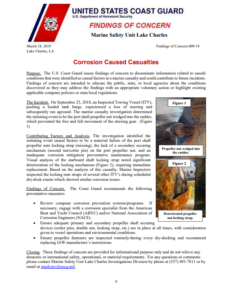The US Coast Guard published Findings of Concern 009-19, “Corrosion Caused Casualties,” aiming to bring awareness to unsafe conditions discovered during 2018 on a Louisiana towing vessel during a marine casualty investigation.
The incident
On September 25, 2018, an Inspected Towing Vessel (ITV), pushing a loaded tank barge, experienced a loss of steering and ran aground.
The marine casualty investigation decided the initiating event to be the port shaft propeller nut wedged into the rudder, which obstructed the free and full movement of the steering gear.
Probable cause
The investigation concluded that the initiating event causal factors were:
- A material failure of the port shaft propeller nuts locking strap (missing);
- Lack of a secondary securing mechanism (second nut/cotter pin) on the port propeller nut;
- Inadequate corrosion mitigation preventative maintenance program.
[smlsubform prepend=”GET THE SAFETY4SEA IN YOUR INBOX!” showname=false emailtxt=”” emailholder=”Enter your email address” showsubmit=true submittxt=”Submit” jsthanks=false thankyou=”Thank you for subscribing to our mailing list”]
In addition, visual analysis of the starboard shaft locking strap highlighted significant deterioration of the locking mechanism, which needed immediate replacement.
According to the analysis of this casualty, Marine Inspectors inspected the locking nuts straps of various ITV’s during scheduled dry-dock exams which indicated similar corrosion issues.
Recommendations
The US Coast Guard suggested the following preventative measures:
- Review company corrosion prevention systems/programs. If necessary, engage with a corrosion specialist from the American Boat and Yacht Council (ABYC) and/or National Association of Corrosion Engineers (NACE);
- Ensure adequate primary and secondary propeller shaft securing devices (cotter pins, double nut, locking strap, etc.) are in place at all times, with consideration given to vessel operations and environmental conditions;
- Ensure propeller fasteners are inspected routinely/during every dry-docking and recommend replacing IAW manufacture’s instructions.
See further details in the PDF below































































